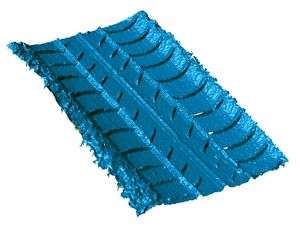3-D images – cordless and any time

Securing evidence at the scene of a crime, measuring faces for medical applications, taking samples during production – three-dimensional images are in demand everywhere. A handy cordless device now en-ables such images to be prepared rapidly anywhere.
The car tires have left deep tracks in the muddy forest floor at the scene of the crime. The forensic experts make a plaster cast of the print, so that it can later be compared with the tire profiles of suspects’ cars.
There will soon be an easier way of doing it: The police officers will only need to pick up a 3-D sensor, press a button as on a camera, and a few seconds later they will see a three-dimensional image of the tire track on their laptop computer. The sensor is no larger than a shoebox and weighs only about a kilogram – which means it is easy to handle even on outdoor missions such as in the forest. No cable drums are needed: The sensor radios the data to the computer via WLAN, and draws its power from batteries.
The sensor was developed at the Fraunhofer Institute for Applied Optics and Precision Engineering IOF in Jena. “It consists of two cameras with a projector in the center,” says IOF head of department Dr. Gunther Notni. “The two cameras provide a three-dimensional view, rather like two eyes. The projector casts a pattern of stripes on the objects. The geometry of the measured object can be deduced from the deformation of the stripes.”
This type of stripe projection is already an established method. What is new about the measuring device named ‘Kolibri CORDLESS’ are its measuring speed, size, weight, and cordless operation. For comparison, conventional devices of this type weigh about four or five times as much and are more than twice the size, or roughly 50 centimeters long. “The reason it can be so much smaller is because of the projector, which produces light with light-emitting diodes instead of the usual halogen lamps,” says Notni. This poses an additional challenge, as the LEDs shine in all directions. To ensure that the image is nevertheless bright enough, the light has to be collected with special micro-optics in such a way that it impacts on the lens.
There are multiple applications: “Patients who snore often need a breathing mask when they sleep. To ensure that the mask is not too tight, it has to be specially made for each patient. Our system enables the doctor to scan the patient’s face in just a few seconds and have the breathing mask made to match these data,” says the researcher.
Notni believes that the most important application is for quality assurance in production processes. The portable device also makes it possible to measure installed components and zones that are difficult to access, such as the position of foot pedals inside a car. The researchers will be presenting their development at the Control trade fair in Stuttgart on April 21 through 25.
Source: Fraunhofer-Gesellschaft





















